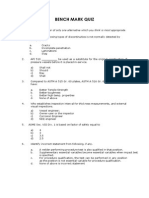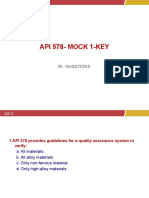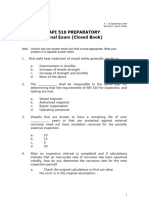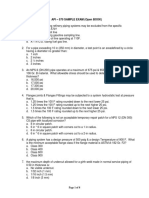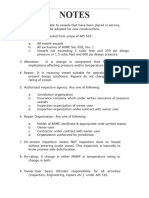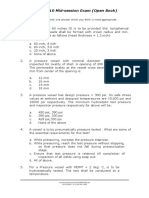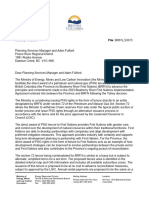API 570 Model Questions-1 PDF
Uploaded by
abdulgafoor54API 570 Model Questions-1 PDF
Uploaded by
abdulgafoor54API 570 Model question-1
The following is a collection of questions remembered by various students who took API 570
exam in the past.
The answers will be found in the following reference publications
API 570, RP 574, RP 578, ASME Sec.V, Sec.IX, B 31.3 & B 16.5(a)
1. What is the height of the raised face on regularly furnished class 300 Raised Face Flanges?
A. 0.06
B. 0.09
C. 0.19
D. 0.25
Section/page _____________________ Reference Publication__________________
2. In a piping system, NPS 4, SMLS material A-53 Grade B, the thickness near a wel is 0.18. The system is designed to
operate at 675 PSIG at 500F. What is the actual remaining corrosion allowance?
A. 0.076
B. 0.080
C. 0.091
D. 0.1
Section/page _____________________ Reference Publication__________________
3. Which of the following are nonessential variables for SMAW?
A. Change of electrode
B. Change in the groove design
C. Change in the PWHT
D. Change in the welding process
Section/page _____________________ Reference Publication__________________
4. When designating an injection point circuit for the purpose of inspection, the recommended upstream limit of the
injection point circuit is__________?
A. Minimum 12 inches
B. Maximum 12 inches
C. Three pipe diameters
D. Both A and C
Section/page _____________________ Reference Publication__________________
5. A process in which a ferrous metal is heated to a suitable temperature above the transformation range and is
subsequently cooled in still air at room temperature is referred to as ____________?
A. quenching
B. Normalizing
C. Annealing
D. Solution heat treating
Section/page _____________________ Reference Publication__________________
6. One advantage of isotope radiography is it _____________
A. Will detect all defects in a pipe weld
B. Can be performed by anyone with little or no training
C. Can not supply a permanent visual record
D. Is not an ignition source in the presence of hydrocarbons
Section/page _____________________ Reference Publication__________________
7. A piping circuit, 300long, operates at 500F. What is the linear thermal expansion of the circuit if the circuit was
constructed using A 106-B piping?
A. 3.62 inches
API 510 Model question-1 Mohan Raj Page 1 of 4
B. 7.24 inches
C. 10.86 inches
D. 14.48 inches
Section/page _____________________ Reference Publication__________________
8. An employer may accept a performance qualification made for another employer provided the ___________________
A. Inspector specifically approves
B. Piping engineer approves
C. Action is allowed by ASME, Section V
D. Other employer is a subcontractor for the current employer
Section/page _____________________ Reference Publication__________________
9. Guided bend specimens for welder qualifications shall have no open defects in the weld or heat affected zone
exceeding ______________
A. 1/16
B. 1/8
C. 3/16
D. no open defects allowed
Section/page _____________________ Reference Publication__________________
10. The inspector is reviewing a radiograph of a pipe weld, the pipe wall is thick. What is the hole type IQI designation
if the penetrameter is placed on the source side?
A. 12
B. 15
C. 17
D. 20
Section/page _____________________ Reference Publication__________________
11. In a piping system, the most susceptible location for cracking is ______________
A. Around supports
B. In welds
C. In bolting
D. In the areas of temporary clamps
Section/page _____________________ Reference Publication__________________
12. What is the PNo. for SA 414 Grade A?
A. 1
B. 2
C. 3
D. 11B
Section/page _____________________ Reference Publication__________________
13. What is the minimum thickness of a class 1500 NPS 4 blind flange?
A. 1.12
B. 1.88
C. 2.12
D. 2.88
Section/page _____________________ Reference Publication__________________
14. The preheat zone shall extend at least ___________ beyond each edge of the weld
A. 6T
B. 12 inches (30cm)
C. wall thickness divided by 3
D. 25 mm (1 inch)
Section/page _____________________ Reference Publication__________________
15. During procedure qualification, how many nick-break specimens are required if the pipe is NPS 8 S/80, 0.500 wall?
A. 1
API 510 Model question-1 Mohan Raj Page 2 of 4
B. 2
C. 4
D. None
Section/page _____________________ Reference Publication__________________
16. The owner/user shall maintain appropriate permanent and progressive records of each piping system. The records
shall include _________________
A. All original construction data
B. System service; classification; identification numbers
C. All ASME requirements
D. Original heat and batch numbers of the system
Section/page _____________________ Reference Publication__________________
17. The maximum carbon content of a mild steel weld deposit is ______________
A. 0.15% carbon
B. 0.20% carbon
C. 0.30% carbon
D. 0.17% carbon
Section/page _____________________ Reference Publication__________________
18. What is the recommended preheat temperature for 1 thick carbon steel?
A. 300F
B. 235F
C. 175F
D. None
Section/page _____________________ Reference Publication__________________
19. An alternative to inspection of buried piping is to leak test the system with liquid at a pressure at least
______________
A. 1 times the Maximum operating pressure
B. 1 times the Maximum operating pressure
C. 10% greater than the Maximum operating pressure
D. Actual
Section/page _____________________ Reference Publication__________________
20. The F number of SFA-5.1 & 5.5 is:
A. 1
B. 2
C. 3
D. All of the above
Section/page _____________________ Reference Publication__________________
21. As a part of general maintenance, any repair organization may make repairs to a piping system as long as:
A. The inspector is satisfied with the competency of the repair organization
B. The piping engineer is on site
C. The repair organization has a contract
D. Their hourly rate is acceptable
Section/page _____________________ Reference Publication__________________
22. Welded joints in carbon steel and carbon-molybdenum steel exposed to elevated temperatures of 800F or over may
be subjected to ______________
A. Pearlite structure
B. annealing
C. graphitization
D. normalizing
Section/page _____________________ Reference Publication__________________
23. What is the allowable undercut for a branch connection in Category D service?
API 510 Model question-1 Mohan Raj Page 3 of 4
A. Zero (no evident imperfections)
B. 1/32 inch
C. 1 mm
D. Both B and C
Section/page _____________________ Reference Publication__________________
24. Changing the weld progression from uphill to down hill will have a major impact on ______________
A. Nick-break strengths
B. Notch toughness properties
C. Tensile strengths
D. Bulge tests
Section/page _____________________ Reference Publication__________________
25. What is the test position when the pipe is horizontal, fixed?
A. 1G
B. 2G
C. 5G
D. 6G
Section/page _____________________ Reference Publication__________________
26. API ______________ provides a detailed discussion of inspection of in-service piping welds.
A. Section IX
B. B 31.3
C. 570
D. B 16.5a
Section/page _____________________ Reference Publication__________________
27. TMLs can be eliminated for piping systems with which of the following characteristics:
A. high potential for creating an emergency in the event of a leak
B. extremely corrosive systems
C. low potential for creating an emergency in the event of a leak
D. piping systems in cyclic conditions at high pressures and temperatures
Section/page _____________________ Reference Publication__________________
28. When determining the corrosion rate, the formulas from API 570 may be used or:
A. Published data on piping system in comparable service
B. Owner/users experience
C. Budget restraints
D. Both A and B
Section/page _____________________ Reference Publication__________________
29. The owner/user shall maintain appropriate permanent and progressive records about each piping system covered by
API 570, this may be done by:
A. The inspectors memory
B. The project managers secretary
C. Computer based system
D. Records are not a requirement of API 570
Section/page _____________________ Reference Publication__________________
30. When the corrosion rte for a piping circuit can not otherwise be determined, the initial thickness measurement
determination shall be made after no more than:
A. 1 year
B. 6 months
C. 3 months
D. 30 days
Section/page _____________________ Reference Publication__________________
API 510 Model question-1 Mohan Raj Page 4 of 4
You might also like
- Daily Points To Recall (Day 8) : Page 1 of 3No ratings yetDaily Points To Recall (Day 8) : Page 1 of 33 pages
- API 570 Interview Questions and Answers: Essential Guide for Piping InspectorsFrom EverandAPI 570 Interview Questions and Answers: Essential Guide for Piping InspectorsNo ratings yet
- Api - 570 Sample Exam (Open Book) : Page 1 of 8No ratings yetApi - 570 Sample Exam (Open Book) : Page 1 of 88 pages
- API 570 - CL Book 111122112010 R0... Mockup 3No ratings yetAPI 570 - CL Book 111122112010 R0... Mockup 318 pages
- API 510 - DAY 3: G T Technical & Management Institute PVT - LTD.100% (1)API 510 - DAY 3: G T Technical & Management Institute PVT - LTD.102 pages
- Calculations Summary Sheet: PD SE Py PD C SE P y PD SE CNo ratings yetCalculations Summary Sheet: PD SE Py PD C SE P y PD SE C2 pages
- API 570 Final Exam Close Book Questions 23100% (1)API 570 Final Exam Close Book Questions 2310 pages
- API 570-Final Model Exam-Open Book Without Answers100% (1)API 570-Final Model Exam-Open Book Without Answers6 pages
- Api 570 Practice Questions (Closed Book)No ratings yetApi 570 Practice Questions (Closed Book)31 pages
- API 510 PC 20 31 Aug05 Mid Session ClosedNo ratings yetAPI 510 PC 20 31 Aug05 Mid Session Closed13 pages
- API 510 Mid-Session Exam (Open Book) : Instructions: Choose Only One Answer Which You Think Is Most AppropriateNo ratings yetAPI 510 Mid-Session Exam (Open Book) : Instructions: Choose Only One Answer Which You Think Is Most Appropriate6 pages
- Final Examination #1: Open Book Questions (1 50)100% (1)Final Examination #1: Open Book Questions (1 50)29 pages
- Non-Destructive Evaluation of Corrosion and Corrosion-assisted CrackingFrom EverandNon-Destructive Evaluation of Corrosion and Corrosion-assisted CrackingNo ratings yet
- API 510 Interview Questions and Answers: The Essential Guide for Pressure Vessel InspectorsFrom EverandAPI 510 Interview Questions and Answers: The Essential Guide for Pressure Vessel InspectorsNo ratings yet
- Straight Tees Inches / Pounds: Schedule 160No ratings yetStraight Tees Inches / Pounds: Schedule 1601 page
- Quality Management System (Qms Iso 9001:2008) Department Log of FilesNo ratings yetQuality Management System (Qms Iso 9001:2008) Department Log of Files2 pages
- Purchase Request Form: Position: Delevery Instruction (Place) : Purpose: SN. Item Description With SpecificationNo ratings yetPurchase Request Form: Position: Delevery Instruction (Place) : Purpose: SN. Item Description With Specification6 pages
- G M Fluidtech PVT LTD: Forged Gate Valve GM160-F11-SWNo ratings yetG M Fluidtech PVT LTD: Forged Gate Valve GM160-F11-SW3 pages
- Industrial Cadre For Operation and Maintenance: 15-Jan-18 25-Feb-18No ratings yetIndustrial Cadre For Operation and Maintenance: 15-Jan-18 25-Feb-182 pages
- Job Safety Analysis Identifying Hazards Checklist: SN Hazards YES NO N/A 1 2 3 4 5 6 7No ratings yetJob Safety Analysis Identifying Hazards Checklist: SN Hazards YES NO N/A 1 2 3 4 5 6 73 pages
- Qa/Qc Department Welding Inspection ReportNo ratings yetQa/Qc Department Welding Inspection Report3 pages
- Industrial Cadre For Operation and Maintenance: Date: 1/3/2018No ratings yetIndustrial Cadre For Operation and Maintenance: Date: 1/3/20181 page
- Purchase Request Form: Position: Delevery Instruction (Place) : Purpose: SN. Item Description With SpecificationNo ratings yetPurchase Request Form: Position: Delevery Instruction (Place) : Purpose: SN. Item Description With Specification6 pages
- No. Vehicle Plate Vehicle Name Vehicle Company Vehicle Color Driver Name Vehicle ModelNo ratings yetNo. Vehicle Plate Vehicle Name Vehicle Company Vehicle Color Driver Name Vehicle Model2 pages
- Industrial Cadre For Operation and MaintenanceNo ratings yetIndustrial Cadre For Operation and Maintenance1 page
- Chemanol-PRJ-17096: 18-Dec-17 25-Dec-17No ratings yetChemanol-PRJ-17096: 18-Dec-17 25-Dec-17762 pages
- Key Features Designed For Limited Access Boiler Tube BevelingNo ratings yetKey Features Designed For Limited Access Boiler Tube Beveling1 page
- Liner Installation in Sump S 8416 Liner Installation in Sump S 8416No ratings yetLiner Installation in Sump S 8416 Liner Installation in Sump S 84162 pages
- Characterization of A Homemade Ionization Chamber For Radiotherapy BeamsNo ratings yetCharacterization of A Homemade Ionization Chamber For Radiotherapy Beams5 pages
- Physics Challenge For Teachers and Students: Solutions To January 2007 ChallengeNo ratings yetPhysics Challenge For Teachers and Students: Solutions To January 2007 Challenge2 pages
- Correspondence - Ministry of Energy, Mines Letter Re Direct Award of A Petroleum and Natural Gas TenureNo ratings yetCorrespondence - Ministry of Energy, Mines Letter Re Direct Award of A Petroleum and Natural Gas Tenure7 pages
- Forces - and Newtons Laws 49 Multi Choice QuestionsNo ratings yetForces - and Newtons Laws 49 Multi Choice Questions28 pages
- 5th Sem. B. Tech. - Power Station Practice - BEEE505T - 30 JuneNo ratings yet5th Sem. B. Tech. - Power Station Practice - BEEE505T - 30 June3 pages
- Testing & Commissioning Procedure For Start Up of Diesel Generator Genset - Best Editable Construction QHSE Documentation PortalNo ratings yetTesting & Commissioning Procedure For Start Up of Diesel Generator Genset - Best Editable Construction QHSE Documentation Portal7 pages
- An Overview of National Climate Change Strategies and Priorities in Papua New GuineaNo ratings yetAn Overview of National Climate Change Strategies and Priorities in Papua New Guinea10 pages
- AM072BXVGFHAA Submital DVM+S2 230V HP 05232022ANo ratings yetAM072BXVGFHAA Submital DVM+S2 230V HP 05232022A2 pages
- Ficha Tecnica Driver Done Brasil PremiumNo ratings yetFicha Tecnica Driver Done Brasil Premium6 pages
- catalog-series-353-integral-pilot-ss-dual-stage-asco-apac-en-9666258No ratings yetcatalog-series-353-integral-pilot-ss-dual-stage-asco-apac-en-96662583 pages
- Procedure For Sectional Field Hydrotest For Di Pipes: Jainco Buildcon Pvt. Ltd.No ratings yetProcedure For Sectional Field Hydrotest For Di Pipes: Jainco Buildcon Pvt. Ltd.11 pages
- API 570 Interview Questions and Answers: Essential Guide for Piping InspectorsFrom EverandAPI 570 Interview Questions and Answers: Essential Guide for Piping Inspectors
- API 510 - DAY 3: G T Technical & Management Institute PVT - LTD.API 510 - DAY 3: G T Technical & Management Institute PVT - LTD.
- Calculations Summary Sheet: PD SE Py PD C SE P y PD SE CCalculations Summary Sheet: PD SE Py PD C SE P y PD SE C
- API 570-Final Model Exam-Open Book Without AnswersAPI 570-Final Model Exam-Open Book Without Answers
- API 510 Mid-Session Exam (Open Book) : Instructions: Choose Only One Answer Which You Think Is Most AppropriateAPI 510 Mid-Session Exam (Open Book) : Instructions: Choose Only One Answer Which You Think Is Most Appropriate
- Non-Destructive Evaluation of Corrosion and Corrosion-assisted CrackingFrom EverandNon-Destructive Evaluation of Corrosion and Corrosion-assisted Cracking
- API 510 Interview Questions and Answers: The Essential Guide for Pressure Vessel InspectorsFrom EverandAPI 510 Interview Questions and Answers: The Essential Guide for Pressure Vessel Inspectors
- Quality Management System (Qms Iso 9001:2008) Department Log of FilesQuality Management System (Qms Iso 9001:2008) Department Log of Files
- Purchase Request Form: Position: Delevery Instruction (Place) : Purpose: SN. Item Description With SpecificationPurchase Request Form: Position: Delevery Instruction (Place) : Purpose: SN. Item Description With Specification
- G M Fluidtech PVT LTD: Forged Gate Valve GM160-F11-SWG M Fluidtech PVT LTD: Forged Gate Valve GM160-F11-SW
- Industrial Cadre For Operation and Maintenance: 15-Jan-18 25-Feb-18Industrial Cadre For Operation and Maintenance: 15-Jan-18 25-Feb-18
- Job Safety Analysis Identifying Hazards Checklist: SN Hazards YES NO N/A 1 2 3 4 5 6 7Job Safety Analysis Identifying Hazards Checklist: SN Hazards YES NO N/A 1 2 3 4 5 6 7
- Industrial Cadre For Operation and Maintenance: Date: 1/3/2018Industrial Cadre For Operation and Maintenance: Date: 1/3/2018
- Purchase Request Form: Position: Delevery Instruction (Place) : Purpose: SN. Item Description With SpecificationPurchase Request Form: Position: Delevery Instruction (Place) : Purpose: SN. Item Description With Specification
- No. Vehicle Plate Vehicle Name Vehicle Company Vehicle Color Driver Name Vehicle ModelNo. Vehicle Plate Vehicle Name Vehicle Company Vehicle Color Driver Name Vehicle Model
- Key Features Designed For Limited Access Boiler Tube BevelingKey Features Designed For Limited Access Boiler Tube Beveling
- Liner Installation in Sump S 8416 Liner Installation in Sump S 8416Liner Installation in Sump S 8416 Liner Installation in Sump S 8416
- Characterization of A Homemade Ionization Chamber For Radiotherapy BeamsCharacterization of A Homemade Ionization Chamber For Radiotherapy Beams
- Physics Challenge For Teachers and Students: Solutions To January 2007 ChallengePhysics Challenge For Teachers and Students: Solutions To January 2007 Challenge
- Correspondence - Ministry of Energy, Mines Letter Re Direct Award of A Petroleum and Natural Gas TenureCorrespondence - Ministry of Energy, Mines Letter Re Direct Award of A Petroleum and Natural Gas Tenure
- Forces - and Newtons Laws 49 Multi Choice QuestionsForces - and Newtons Laws 49 Multi Choice Questions
- 5th Sem. B. Tech. - Power Station Practice - BEEE505T - 30 June5th Sem. B. Tech. - Power Station Practice - BEEE505T - 30 June
- Testing & Commissioning Procedure For Start Up of Diesel Generator Genset - Best Editable Construction QHSE Documentation PortalTesting & Commissioning Procedure For Start Up of Diesel Generator Genset - Best Editable Construction QHSE Documentation Portal
- An Overview of National Climate Change Strategies and Priorities in Papua New GuineaAn Overview of National Climate Change Strategies and Priorities in Papua New Guinea
- catalog-series-353-integral-pilot-ss-dual-stage-asco-apac-en-9666258catalog-series-353-integral-pilot-ss-dual-stage-asco-apac-en-9666258
- Procedure For Sectional Field Hydrotest For Di Pipes: Jainco Buildcon Pvt. Ltd.Procedure For Sectional Field Hydrotest For Di Pipes: Jainco Buildcon Pvt. Ltd.


















